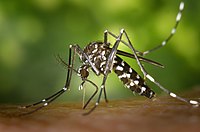
Photo from wikipedia
Abstract Soil as a shared habitat of white grubs and entomopathogenic nematodes (EPNs) is a double-edged sword from the biological control point of view. Soil encompasses a diverse array of… Click to show full abstract
Abstract Soil as a shared habitat of white grubs and entomopathogenic nematodes (EPNs) is a double-edged sword from the biological control point of view. Soil encompasses a diverse array of EPNs that could be exploited in grub microbial control; on the other hand, soil promotes the natural resistance of grubs to EPNs via the battle between both sides within the soil matrix. White grubs and EPNs have been armed in this battle by a multifaceted range of mechanisms, namely grub structural and physiological barriers, antagonism of grub gut microbiota toward the nematode bacterial symbionts, EPN excreted/secreted proteins, surface coat proteins, ascaroside pheromones produced by EPNs, and evolution of EPN resistance to herbivore self-defense. From the evolutionary point of view, EPN–grub interactions, the most advanced (sophisticated) association among others, could have evolved from other types of associations. Entomophilic nematode (e.g., Pristionchus spp.), the cognate bacterium and scarab associations along with the formation of dauer juveniles, are proof of preadaptation to entomopathogeny in a continual evolution. Here, we delve into the salient features of each component of EPN-white grub–host plant tripartite interactions as well as hints to improved exploitation of EPNs for grub management. Also, evolutionary associations between nematodes and scarabs will be reviewed, in short. Graphical Abstract
Journal Title: Annals of the Entomological Society of America
Year Published: 2021
Link to full text (if available)
Share on Social Media: Sign Up to like & get
recommendations!